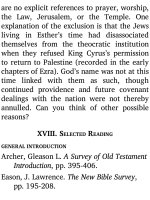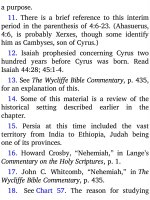Jensens survey of the old testament adam 263
Bạn đang xem bản rút gọn của tài liệu. Xem và tải ngay bản đầy đủ của tài liệu tại đây (160.35 KB, 4 trang )
unsurpassed in the Hebrew Scriptures.
Concerning chapter 3, Unger writes:
The magni cent lyric ode of ch. 3
contains
one
of
the
greatest
descriptions of the theophany in
relation to the coming of the Lord
which has been given by the Holy
Spirit, awaiting ful llment in the day
of the Lord (cf. 2 Thess 1:7-10).23
II. SURVEY
1. Read through the book twice. What
words and phrases stand out as prominent
ones?
2. Compare 1:1 with 3:1. Also compare
1:2 with 3:18-19. What are your
observations?
3. Study the survey Chart 113 very
carefully. The questions or suggestions given
below are based on the chart.
4. Read each paragraph of the Bible text
and assign a title to each paragraph.
5. How much of the book records
Habakkuk’s words? God’s words?
6. Note the three-part outline showing a
progression of the prophet’s mental
attitudes.
7. Note the three-part outline at the top of
the chart. Compare the introductory verses
of each of those parts.
8. In what sense is the last chapter the
highest peak of the book?
9. Note the key words. Read the key
verses in the Bible. Add to the two lists as
you proceed with your study.
III. APPLICATIONS
1. Does God have a listening ear to
complaint, of whatever sort it is? How did
God react to Habakkuk’s complaining?
2. What other sins does doubt lead to?
3. What does the Bible teach about
patience and endurance? See Romans 5:3-5.
Why does God often move slowly in
performing His work?
4. Compare Galatians 2:20 and Habakkuk
2:4.
5. What is the ultimate test of one’s faith?
Compare your own faith with Habakkuk’s, as
he testified in 3:17-19.
6. Compare Paul and Habakkuk, as the
two men are represented by their









